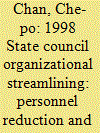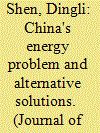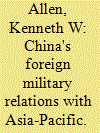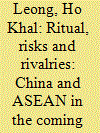|
|
|
Sort Order |
|
|
|
Items / Page
|
|
|
|
|
|
|
| Srl | Item |
| 1 |
ID:
020482


|
|
|
|
|
| Publication |
Nov 2001.
|
| Description |
553-572
|
| Summary/Abstract |
The two goals of the 1998 State Council organizational streamlining were personnel reduction and a change of government functions. It is argued that the methods being used to achieve personnel reduction do not constitute a real reduction but largely involve transferring staff to other public institutions. Real personnel reduction could not be achieved without a major change of government function. Institutional reforms of both the central and local governments since the 1980s have been adaptations to the changing economic structure from a planned to a market economy. Government functions have served both existing economies. Cadres cannot be reduced unless the government function of direct management of state-enterprises is completely severed. The major contents of the 1998 institutional reform are examined and evaluated. The prospects for the success of the reform are also assessed
|
|
|
|
|
|
|
|
|
|
|
|
|
|
|
|
| 2 |
ID:
020485


|
|
|
|
|
| Publication |
Nov 2001.
|
| Description |
663-681
|
| Summary/Abstract |
Tremendous changes have taken place in East Asia in the post-Cold War era, which have a great impact on Chinese foreign policy and its relations with major powers in East Asia. This new power configuration is related to as 'two ups' and 'two downs', which have become apparent since the early 1990s. The 'two ups' concern the rise of the United States and China. The United States' rise to sole superpower status has given Washington a dominant role in all four dimensions of world affairs: political, strategic, economic, and technological/cultural. Meanwhile, China has achieved a spectacular economic performance for the past two decades, sustaining high growth rates, and escaping, so far, the Asian economic crisis of 1997–98. This expansion has greatly increased China's influence in regional and global affairs. The 'two downs' refer to the downturns of Russia and Japan. This article provides a detailed analysis of China's international environment in the context of the changing dynamics of major-power relations in East Asia. Special attention is paid to the crucial Beijing–Tokyo–Washington triangle. The examination focuses upon political, economic, and strategic dimensions.
|
|
|
|
|
|
|
|
|
|
|
|
|
|
|
|
| 3 |
ID:
020488


|
|
|
|
|
| Publication |
Nov 2001.
|
| Description |
717-722
|
| Summary/Abstract |
China is facing a myriad of internal challenges and problems, the energy issue being one of the most outstanding of them. With the rapid development of the Chinese economy, there emerged acute energy and environmental problems which need to be alleviated. This paper examines this challenge, and puts forward alternative solutions. It also evaluates its impact on regional security
|
|
|
|
|
|
|
|
|
|
|
|
|
|
|
|
| 4 |
ID:
020484


|
|
|
|
|
| Publication |
Nov 2001.
|
| Description |
645-662
|
| Summary/Abstract |
The People's Liberation Army has always had a significant role in shaping and implementing the People's Republic of China's foreign policies. Over the past two decades, the PLA's role has increased considerably, and is likely to become even more important in the future as China develops its military capabilities and casts a broader shadow in the Asia–Pacific region. The PLA's foreign relations program has several goals: to shape the international security environment in support of key Chinese national security objectives; to improve political and military relations with foreign countries; to enhance China's military and defense industry modernization; to provide military assistance to countries in the developing world; and, to acquire knowledge in modern military doctrine, operations, training, military medicine, administration, and a host of non-combat related areas. The PLA seeks to accomplish these goals through its military attache´ offices abroad and the use of an elaborate system of bilateral exchanges. Of these programs, the most visible relations involve high-level visits, functional exchanges, arms purchases, and ship visits.
|
|
|
|
|
|
|
|
|
|
|
|
|
|
|
|
| 5 |
ID:
020483


|
|
|
|
|
| Publication |
Nov 2001.
|
| Description |
587-612
|
| Summary/Abstract |
This paper investigates China's economic growth potentials and limitation up to 2020 and recommends a trend of economic regionalization. A sustainable growing economy is a necessity for China's future stability. The growth sustainability of the Chinese economy depends essentially on its continued commitments to institutional reform and economic deregulation. China's relaxation of government intervention in economic activities has led and will be leading China to decentralize its central governmental authority over economic planning and control. This will consequently stimulate the emergence of regional economies in Mainland China. In the next two decades, there will likely be 10 regional economies with relatively independent industrial structures emerging in Greater China (or the Chinese Economic Area of Hong Kong, Macao, Taiwan and the Mainland) as a result of economic liberalization and decentralization.
|
|
|
|
|
|
|
|
|
|
|
|
|
|
|
|
| 6 |
ID:
020487


|
|
|
|
|
| Publication |
Nov 2001.
|
| Description |
695-710
|
| Summary/Abstract |
The integration of the so-called greater China economies among Mainland China, Taiwan, and Hong Kong is one part of the global trend of regionalism. The significance of integration in terms of foreign trade and foreign direct investment demonstrates not only rapid growth but also diversity, ever since Mainland China pursued her open door policy of economic reform in 1979. For instance, the combined volume of Hong Kong and Taiwan accounted for as much as 74.1% of Mainland China's capital utilization in 1993, which in turn contributed to the rapid economic growth of Mainland China over the last two decades. The membership of Mainland China and Taiwan to the WTO, as expected by the end of 2001, will facilitate a more official arrangement of intergovernmental coordination within these Triangle Economies. However, the government of Taiwan will continue to evaluate the cross-strait relations in the context of the nation's overall political and economic security as long as the government of Mainland China does not renounce the use of military force against Taiwan.
|
|
|
|
|
|
|
|
|
|
|
|
|
|
|
|
| 7 |
ID:
020486


|
|
|
|
|
| Publication |
Nov 2001.
|
| Description |
683-694
|
| Summary/Abstract |
This paper argues that Sino–ASEAN relations, despite reassurances and determination by both sides to increase interactions and cooperation, have some remaining areas of contention and contestation. After its long isolation, self-imposed or otherwise, the PRC has been able to integrate itself successfully into the political life, economies, and security interests of the region. The PRC's market potentials, military capabilities and its enormous size have both excited and threatened the Southeast Asian states. While the Southeast Asian states have been willing to engage this emerging regional power, they are also wary of the potential risks when dealing with it. Increasing trade, investment, and cultural levels between the two regions have made both sides increasingly aware of the opportunities and challenges involved. The relationship is not without problems, although there is a general consensus that it is on a much better footing than in recent decades. The present developments of their relationships and in the next decade are analyzed under three categories: rituals, risks and rivalries.
|
|
|
|
|
|
|
|
|
|
|
|
|
|
|
|
|
|
|
|
|